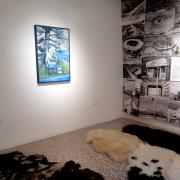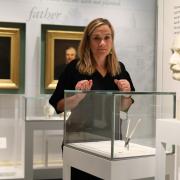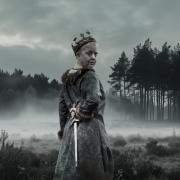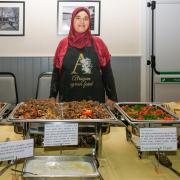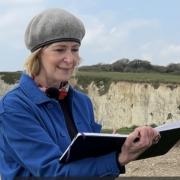Two Dorset villages, Portesham and its neighbour Abbotsbury are coming together this summer to mark a very special milestone the millennium of their founding.
King Cnut’s Portesham Charter
Portesham, set within the Dorset National Landscape, is located between Weymouth and Bridport on the B3157 adjacent to the Jurassic Coast. Four miles to the west along that same road is Abbotsbury. These neighbouring villages are marking a millennium milestone.
Portesham is celebrating its 1000th birthday as a defined parish. The original charter, which can be seen in the Dorset Archives, defines the boundary of the manor that was given by King Cnut (c. 990 –1035) to his manservant Orc. Although there is evidence of humans inhabiting the area since Neolithic times, this 1024 charter is the first written record of the area being named as ‘Porteshamme’. Anglo-Saxon boundary clauses, which describe the boundaries of land in old English or Latin, are recorded in charters from the 7th to the 11th century, like the land registry plans of today. These correspond closely with the present Portesham boundary. To commemorate this millennium milestone a sign has been designed for Portesham’s village green with Anglo Saxon Village, 1024 alongside a copy of the original charter. Our millennium logo, which represents both Abbotsbury and Portesham, is by Bruce Duckworth the award-winning designer behind Amazon’s famous smile logo. He offered to create it after attending one of our meetings about the millennium celebrations.
According to the 1086 Domesday Book, Portesham had 34 households, 24 acres (9.7 hectares) of meadow and 9 ploughlands, putting it in the largest 40% of settlements recorded in Domesday. In the UK census of 2011, Portesham had a population of 685 in 316 households. So, a relatively small village in today’s terms.

The growth of Portesham has, in part, been due to people moving here over time. In the 1881 census of approximately 900 villagers, 80% were born in Portesham. Most of the remainder came from other parts of Dorset, but there were some from as far afield as London, Suffolk and Surrey.
The village still has a mix of families that have been here for centuries alongside people who have moved here, including more recently three Ukrainian families who have been welcomed by the Portesham Refugee Support Group. It’s interesting to note that at the time of King Cnut, the three main written languages - Latin, English and French - coexisted with spoken English, Danish and French. However, especially in towns, several other languages - Welsh, Irish, Flemish and German - were also spoken by people who had settled there from other countries. Multi-culturalism is nothing new!

Return of the Portesham Native
Having grown up in this parish, moving away when I was 18, I returned to Portesham three years ago. As a teenager I worked in the village shop and later frequented the pubs. We’re fortunate that the village still has one of each. The school, church, village hall and pub remain focal points for the community to come together.
In my younger days the village hall was used for youth club events and jumble sales, moving to its present location in 2000. The number of groups that use this community space - including Scouts, WI, bowls, a monthly film night, cafes and Portesham Arts Group - is testament to the vibrant community spirit that thrives here. The Portesham Volunteers help to maintain the land around the hall as well as other areas of the village. This includes Dovecot, a wildflower area at the top of the village, which has been developed into a Millennium Garden.
When I came back to the village, I joined all sorts of activities that have resulted in me finding new talents and revitalising old skills. My first taste of volunteering was a dry stone walling course organised by Portesham Volunteers. With the support of the Dorset Dry Stone Walling Association the group rebuilt the wall at Goose Hill using a style, a mortared layer about half-way up the wall, which seems to be unique to Portesham. I also got involved with the group raising money to put a toilet into St Peter’s Church. Then, before I knew it, I was chairing the group co-ordinating the village’s millennium celebrations.

As I discovered, you will be welcomed with open arms if you want to get involved in village life. Equally there are plenty of opportunities for more passive engagement by attending the many activities here.
For an opinion on how the village has changed, I spoke with Sue White (nee Chipp) and Sarah Chipp. There have been Chipps living in Portesham for centuries, the first record that I found is the marriage of John Chipp in 1672. Sue, Sarah and their family continue to farm here and say that though the number of businesses in the village has reduced over the decades, they find it is ‘more sociable’ with lots of groups and events. They are both actively involved with Cub and Beaver groups, as well as the warm space café in the Methodist Hall.
This friendliness and support are echoed by Sue and Ruari Chisholm who moved to Portesham around the same time I did. They were struck by how many people came round to welcome them. ‘We spoke to more people on that first morning then we did in 20 years of living in Kent!’ And when they did attend events in the village hall, they were invited to join others rather than sitting on their own. They also praised the village Whatsapp group. Many a lost cat or dog has been located via this group! It’s also where many villagers put out a call for help or answer that call.
The idea to celebrate Portesham’s millennium has really brought out the best of the village with people helping to organise events, such as the children’s art festival at the village school’s open day, as well as supporting them by buying t-shirts, making key rings and wood mementos. Fayre Through the Ages (July 27), which will encompass the last thousand years, will showcase charities, businesses and groups in both Portesham and Abbotsbury, celebrating all that is so positive in our little Dorset villages.

What are the secrets to a thriving village?
At the heart of the Portesham is a community of villagers who are happy to get involved with organising activities and supporting each other. We always extend a warm welcome to newcomers to the village, but there is also a continuing presence of families who have been living in the village for generations. The support provided by villagers to each other is both on a personal basis and via the village Whatsapp group where requests for help are responded to by many people. Our informative village website is constantly updated with news and events and there are lots of groups and activities happening that appeal to different age groups including Scouts, WI, arts events, cafes and warm spaces meet ups and lunches. There is also a very pro-active church which is open to all, a village pub which holds regular social events and a parish council that works hard for the local community.

A Stitch in Time at Abbotsbury
We know that homo sapiens have been living in and around Abbotsbury since 4,500BC with evidence of Neolithic occupation in the area. The Ridgeway above Abbotsbury village was very important during both the Bronze and Iron Ages. ‘Abbotsbury Castle’ Iron Age earthworks formed part of the chain of ancient fortifications which includes Maiden Castle, one of the largest and most complex Iron Age hillforts in Europe, just south of Dorchester.
The resident Durotriges tribe battled unsuccessfully with the Romans around 44AD. Their occupiers were later replaced by Saxons and then Vikings as invading forces landed on these Dorset shores and eventually settled here.
It is from this time that we take up the story of this year's millennium celebrations. These also have a special resonance for Abbotsbury, even if the evidence is scanty. Unlike Portesham which still has its original charter, the evidence for our village charter has been trickier to locate. The Abbotsbury Abbey registers (scattered during the Civil War) claim that the first church was built here ‘in the very infancie of Christianity’ and that Abbotsbury was given to Glastonbury Abbey 80 years before King Cnut granted the land to Orc in 1024. Both those charters have long since vanished.
Local resident, Nigel Melville, unearthed the Julius Work Calendar of 1020 depicting people working on the land. Nigel’s wife, Sue, a textile design artist, was asked by the vicar of St. Nicholas, our village church, to devise a record of the thousand years of the role of the church in Abbotsbury. The original idea of a banner was replaced by a 12-month pictorial 'Calendar’, inspired by Nigel’s discovery, where each month has a sketch of what happens on the land from January to December, stitching the story of farming told in intricate detail.

Sue takes up the story: ‘The fabric and stitching had to be sympathetic with the original idea, so we chose calico which pre-school children from the village dyed with tea to give it the right tone of colour. Transferring the design onto the fabric took quite a lot of research and experimentation, but we achieved this with help of a lightbox.’
There were 14 ‘Calendar Girls’ from the village, as Sue calls them, who worked on the 12 panels. ‘The thread used is crewel wool in dark red, and we used back stitch to follow all the curving sketched lines. The effect is amazing. We have managed to bring the year 1020 back to vivid life.’ The 12 panels have been put together to create a large screen that can now be viewed in St Nicholas Church.
‘The screen will be dedicated by the Bishop of Salisbury on July 14 and the Calendar Girls know that their work will stay in the church for ever. Stitchers throughout history have depicted events with their needles and we can join their ranks.’
This work of art has now been registered with the National Needlework Archive, along with the 108 kneelers that villagers have already made for the church.








